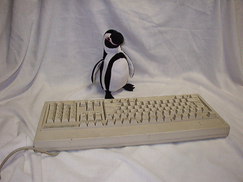
LINKS:
- Linux Weekly News
The best update on what's happening - BasicLinux
- A more concise BasicLinux page
Monitor/Graphics Cards Links
Linux
What's to say? Everyone has now heard about Linux. I started with Red Hat (5.2) and am now running Slackware (actually, Slackintosh on a PowerPC G4 Mac). I prefer using XFCE and Abiword rather than Gnome or KDE and OpenOffice, since it's just a bit snappier. Probably to suit my family of technically-nonmotivateds, I ought to get Gnome or KDE up with clicky icons and no need to revert to the command line. I tried to teach them...
My main beef with Linux vis-a-vis DOS is (1) the lengthy boot-up cycle, and (2) you can't just turn it off. With journalling filesystems, #2 is not so much a problem anymore, and I know people are working the boot-up time issue. The other problem with Linux is it's pretty much targetted to new hardware, not my collection of 486es and 133MHz pentiums (pentia?), even though there is an effort to backport bugfixes - not clear how much the 2.2 kernel for BasicLinux will benefit. Remains to be seen.
November 30 2009: Back to the PeeCee
The G4 Mac "died". Well, not really, outside of a file system corruption issue that would require me rebuilding the disk. And a fan with blown bearings, I'm guessing. But Slackintosh, being an unofficial "child" distribution, isn't keeping up with the main, peecee-oriented Slackware parent. Plus, the Mac isn't a real "CHrP" or "PreP" or whatever the "pure" PowerPC computer platform would be; it is an Apple product, and they do things differently at least in part to keep you out from under the hood. If I could have expunged all Apple-ness from the machine, it might have been different, but I was obliged to keep a few mysterious HFS partitions at the top of the drive just to get it to boot.
So there were enough "this isn't as fun as I thought it would be" and enough "it isn't working right anymore, anyways" to induce me to pull out a Raytheon surplus HP peecee and replace it. I don't think it's as fast. It definitely isn't as cool. But I've got an up-to-date Slackware and Firefox on it. Oh, well...
March 31 2008: Old Monitors Specs
I found out where I can recycle computer junk in Tucson (Pima Computer Recyclers for working junk, and Household Hazardous Waste for the rest of it), so I cleaned out my "lab", including a flatbed scanner and an IBM PS/2 (what a worthless machine). I had accumulated a large number of monitors, too, and wanted to keep the best. It's hard to find monitor stats, but after a lot of googling, I found some good links, listed to the left.
July 04 2007: Proprietary Software
Last Christmas, my sister prevailed upon my dad to give us a Macintosh, because (if I understand correctly), she believed that I was depriving my children of useful computer education, and/or of having an actually useful computer, as opposed to my hobby rigs. Okay, there it is in the other room. I've forgiven my sister, and I have to put up with Mac OS X. I also appear to have to put up with my children preferring the glitzy, easy Mac OS X applications over somewhat more cumbersome Linux applications. But I want them to understand the problems associated with proprietary Apple-owned software. And (if possible) my sisters and brother and dad and their families. And whoever may read this:
You use whatever word processor on the Mac. Chances are, nothing but that word processor program will ever be able to manipulate the files you create on it. The same is true for Word for Windows; however clever the open-source competitors may be, their programs will never be able to implement everything that Microsoft and Apple put into their proprietary programs. You create a file using a proprietary application, you are locked in to that application. You are enslaved. You are NOT FREE.
Now, in some cases, that can't be helped. If you need to do video productions, or video editing,  Macs are the best tool for the job, and the applications are all proprietary. Open Source alternatives are simply not there yet, and I'm not so much an idealogue as Richard Stallman to choose to not do a job if it can't be done with free (as in liberty) software. But pretty much everything teen schoolchildren are going to do can be done with free software, and therefore should be done with free software.
Macs are the best tool for the job, and the applications are all proprietary. Open Source alternatives are simply not there yet, and I'm not so much an idealogue as Richard Stallman to choose to not do a job if it can't be done with free (as in liberty) software. But pretty much everything teen schoolchildren are going to do can be done with free software, and therefore should be done with free software.
You might say, "So what? So I'm locked into Word [or whatever exists in OS X]?" What if Microsoft creates a new version of Word? Eventually, support for the version you created your files with will be dropped. Old versions will be unobtainable (Microsoft owns them, of course). Or worse, the scenario faced by many of us old-computer types: Some company creates a great program, but then goes out of business. The program is OUT there, but you can't legally obtain it! The dead company still holds the copyright, even if they can't sell it anymore!
So there are ethical AND pragmatic reasons for not wanting to use proprietary software. I certainly would have expected homeschoolers to understand this point!
Dec 26 2006:
I am now an APPLE COMPUTER user!
I friend at Raytheon upgraded his Mac rig to a quad G5 for editing photos (a bit of overkill), so he offered to let me play with his old G4 and decide if I wanted to buy it off him. After a long time of playing half-heartedly with Debian PPC and Ubuntu, I discovered Slackintosh. I really like Slackware, so I wasn't really interested in moving away from it for the sake of a more capable machine, but now I find I can have my cake and eat it, too!
Way too much room on the hard drive (160GB). Moving data from the peecee to the Mac was a chore. I've got to learn some network fundamentals; this would have been easy with even a crossover cable. I dread backing up this monster. I will have to get a USB hard drive for backup.
Wow. Speed. Huge monitor (1600x1200; nine terminal sessions will fit on the desktop!). I can run KDE, although XFCE works fine, too. Well, okay, I could have run KDE on the old machine, like I am on the 133MHz P2 machine in the lab, for which I need KDE to run the GNU PIC tools, but it would be p_a_i_n_f_u_l_l_y slow. Compiles are wonderful - I can build a new kernel in about half-an-hour. And it's a PowerPC! Yes, the PowerPC era is over (thanks, Motorola/Apple), but it's refreshing to use a machine that was designed, rather than evolved - an aesthetic point, rather than practical one. The only thing that doesn't work (so far) is viewing Flash files, since Adobe is so unenlightened as to only release binaries, and x86 binaries at that. However, I understand there is a workaround using QEMU. Right now, though, I am enjoying not having to deal with Barbie animations, which is mostly what Flash supported on the old machine.
Internet at 56K Dialup is same as always. It's still nicer on a faster machine. Someday I will consider DSL. Maybe.

